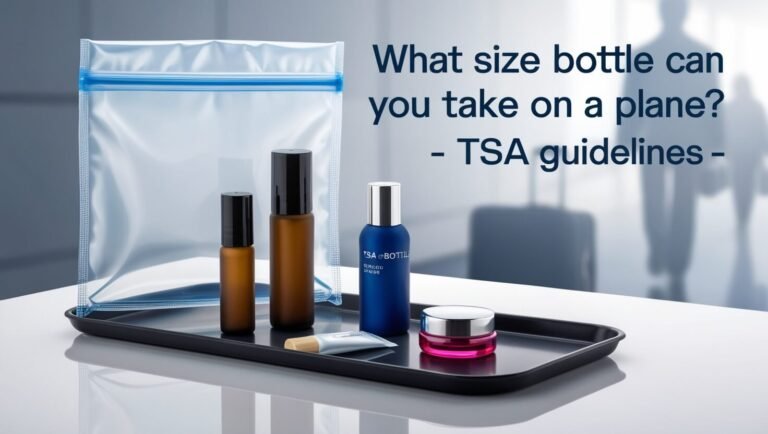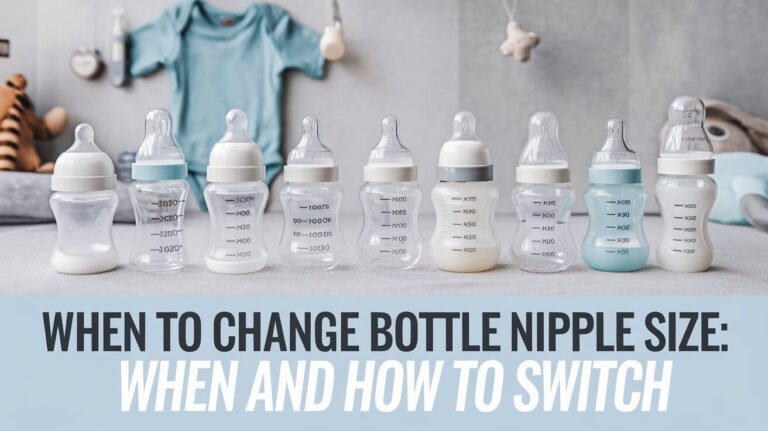What Size Bottle Can You Bring on a Plane: Your Travel Essentials

Traveling by air can be challenging, especially with the TSA’s carry-on liquid rules. You might be thinking, “What size bottle can I bring on a plane?” The answer might be more than you expect.
TSA 3-1-1 Rule for Carry-on Liquids
The Transportation Security Administration (TSA) has rules for carry-on liquids, gels, and aerosols. The “3-1-1 rule” makes screening easier and safer.
Quart-sized Bag Requirements
Each passenger can carry one clear, quart-sized plastic bag. It should have travel-size containers of liquids, gels, and aerosols. These must be 3.4 ounces or less per item. Packing four or five 3.4-ounce bottles in the bag is a good idea.
Measurement Guidelines for Containers
The TSA says all containers must be 3.4 ounces or less. This includes toothpaste, shampoo, and lotion. You can also carry alcohol in containers less than 3.4 ounces and less than 70% alcohol content.
Proper Packing and Presentation
Put all your 3.4-ounce or less items in the clear, quart-sized plastic bag. Then, present it separately at the security checkpoint. This makes screening easier and faster.
| Allowed Liquids | Prohibited Liquids |
|---|---|
| Creamy cheeses Liquid chocolate Coffee Dips and spreads Honey Jam Juice Syrup Peanut butter Salad dressing Salsa Soup Yogurt | Wet foods exceeding 3.4 ounces Firearms of any type |
Knowing the TSA’s 3-1-1 rule helps travelers pack better. It makes airport experiences smoother and more efficient.
What Size Bottle Can You Bring on a Plane
When flying, it’s crucial to know the TSA’s liquid rules. The size of your carry-on liquids, gels, or aerosols is key. The TSA lets you bring containers up to 3.4 ounces (100 milliliters) in your carry-on.
These containers must fit in a clear, quart-sized, zip-top bag. This rule helps keep the amount of liquids in check. Any bigger containers must go in checked luggage or stay home.
| Liquid Rules | Container Size | Carry-on Allowance |
|---|---|---|
| Liquids, Gels, and Aerosols | 3.4 oz (100 ml) or less | 1 quart-sized bag per passenger |
| Prescription Medications | No size limit | Exempt from 3-1-1 rule |
| Baby Formula and Food | No size limit | Exempt from 3-1-1 rule |
The TSA’s liquid rules have been around for over 15 years. Knowing these rules helps avoid security issues. Packing the right size containers ensures a hassle-free flight.
Special Exemptions for Liquid Restrictions
The Transportation Security Administration (TSA) has strict rules for liquids in carry-on bags. But, there are some exceptions. People with medical needs, parents of infants, and those with duty-free items can carry more liquids.
Medical Necessities and Documentation
Prescription liquids, gels, and aerosols are okay in carry-ons in the U.S. Medications and contact lens solutions are usually limited to 3.4 ounces. But, more is allowed if you have the right documents.
Baby Formula and Child Nourishment
- Formula, breast milk, toddler drinks, and baby/toddler food over 3.4 ounces are okay in carry-ons.
- Ice packs, freezer packs, and frozen gel packs to keep these items cool are also allowed.
Duty-Free Purchase Guidelines
Duty-free liquids in sealed, tamper-evident bags are okay through security. They must be bought within 48 hours of your flight. And, you need the original receipt.
“Travelers with medical necessities, infant and child nourishment, and duty-free purchases can often bring larger quantities of liquids through airport screening procedures.”
Knowing these exceptions helps travelers move through security smoothly. It ensures they can carry the liquids they need for a comfortable trip.
Common Travel Items Subject to Liquid Rules
Knowing the TSA’s liquid rules is key for travel packing tips and aviation security. These rules cover many items people pack in their bags.
Toothpaste, shampoo, conditioner, mouthwash, and lotion must follow the 3-1-1 rule. Each item must be 3.4 ounces or less. They must also fit in a quart-sized bag. You can carry one such bag per person.
The 3-1-1 rule only applies to carry-on bags. Items in checked bags don’t have these size and quantity limits. But, they can’t be hazardous materials.
| Item Category | Permitted in Carry-on | Permitted in Checked Bag |
|---|---|---|
| Liquids, Aerosols, Gels | 54% | 86% |
| Items with Special Instructions | 17% | 14% |
Understanding these travel packing tips and aviation security rules helps avoid problems at security. It makes your trip smoother.
International Travel and Duty-Free Purchases
Traveling internationally can be complex, especially with duty-free purchases and airport security. But, with some preparation and knowledge of TSA rules, it’s easier. You can manage your duty-free liquids and have a smooth airport experience.
48-Hour Purchase Window Requirements
For international travelers, the 48-hour rule for duty-free liquids is crucial. TSA says you can carry duty-free items like perfumes and liquor in your carry-on. They must be bought in the last 48 hours and have the original receipt.
Tamper-Evident Packaging Rules
Duty-free liquids also need to be in secure, tamper-evident packaging. This makes sure they haven’t been opened and can be checked by security. The TSA wants these items in clear, tamper-evident bags for easy inspection.
Connection Flight Procedures
Travelers with connecting flights to the U.S. face extra screening at the final security checkpoint. Duty-free items in carry-on bags will get a detailed check. If they fail, they must go in checked luggage.
By knowing and following these rules, international travelers can bring their duty-free items on flights. This makes for a hassle-free airport experience.
In Closing
Knowing the TSA rules for liquids and aerosols is key for a smooth flight. Following the 3-1-1 rule for carry-on liquids is important. Also, being aware of exemptions for medical needs and baby food helps a lot.
Following the rules for duty-free items is also crucial. This knowledge makes going through travel regulations and aviation security checkpoints easier.
Being prepared and paying attention to these details saves time. It also avoids problems at the security check. By knowing the liquid rules and packing right, travelers can enjoy their trip more.
Keeping up with the latest TSA rules makes air travel better for everyone. A bit of planning and organization helps. This way, passengers can follow the travel regulations and have a great trip.
Common Questions:
What is the TSA 3-1-1 rule for carry-on liquids?
The TSA 3-1-1 rule lets you carry one quart-size bag of liquids, gels, and aerosols. Each item must be in a container of 3.4 ounces (100 milliliters) or less. This includes toothpaste, shampoo, conditioner, mouthwash, and lotion.
What size bottles can you bring on a plane in your carry-on bag?
You can bring bottles of liquids, gels, or aerosols up to 3.4 ounces (100 milliliters) in your carry-on. These must fit in a single, clear, quart-sized, zip-top bag. Bigger containers need to go in checked luggage or stay home.
Are there any exemptions to the liquid restrictions?
Yes, there are exemptions. Medications, infant and child nourishments, and duty-free items are allowed. Medications and child items can be bigger but need extra screening. Duty-free items in tamper-evident bags are okay if bought within 48 hours and with a receipt.
What common travel items must comply with the 3-1-1 liquids rule?
Items like toothpaste, shampoo, conditioner, mouthwash, and lotion must follow the 3-1-1 rule. They need to be in containers of 3.4 ounces (100 milliliters) or less and fit in a quart-sized bag.
What are the requirements for bringing duty-free liquids on international flights to the US?
For international flights to the US, duty-free liquids over 3.4 ounces are okay if you meet certain rules. They must be in tamper-evident bags, bought within 48 hours, and with a receipt. These items need extra screening. If they can’t pass, pack them in checked luggage.




